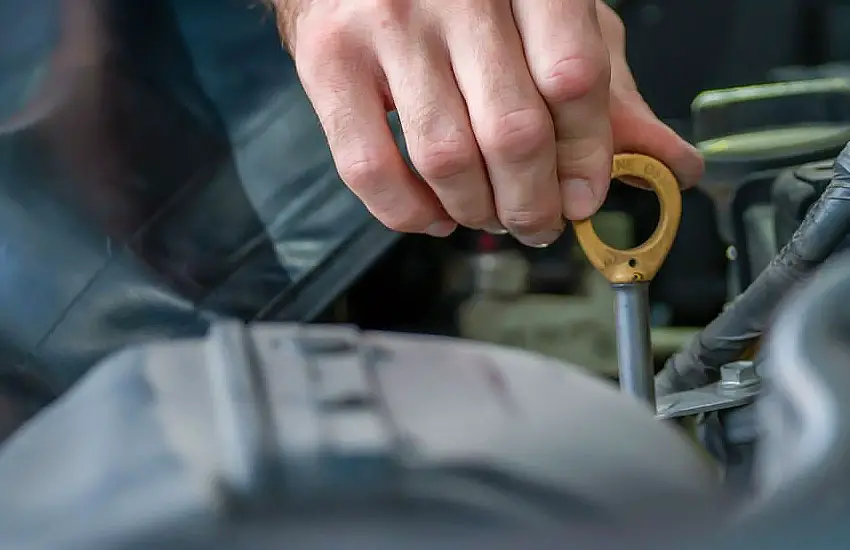As an Amazon Associate, I earn from qualifying purchases at no extra cost to you.
How to Test Transmission Speed Sensor: Quick Steps!
You might be wondering about your car's performance, especially when it comes to shifting gears. If you notice strange sounds or delays, it could be time to check your transmission speed sensor. In this blog post, we'll dive into How to Test Transmission Speed Sensor. You'll learn easy steps to figure out if the sensor is working right. Don't worry; we'll keep things simple and straightforward, so you can get back on the road without any hassle!
How to Test Transmission Speed Sensor: The Ultimate Guide
Testing a transmission speed sensor is an important diagnostic step when dealing with transmission issues in a vehicle. A faulty speed sensor can lead to problems such as erratic shifting, inaccurate speed readings on the dashboard, and even transmission failure. Here's a detailed guide on how to test a transmission speed sensor:

Tools and Materials Needed
- OBD-II Scanner: For reading diagnostic trouble codes (DTCs).
- Multimeter: For measuring voltage and resistance.
- Wrench Set: For removing the speed sensor.
- Replacement Speed Sensor (if needed): If the sensor is faulty.
- Safety Glasses: For eye protection.
- Shop Manual: For your specific vehicle make and model (optional but helpful).
1. Safety First
Before you start testing the transmission speed sensor, safety is the most important thing to think about. First, make sure the vehicle is parked on a flat surface. This helps to keep the car from rolling. Then, turn off the engine to ensure that there are no moving parts while you work. It is also a good idea to engage the parking brake. This is a lever or button that keeps the car in place and prevents it from rolling away.
After that, you should disconnect the battery. This means taking off the negative cable from the battery terminal. Doing this helps avoid any electrical shorts, which can cause damage to the car’s systems or even hurt you. Lastly, remember to wear safety glasses. This is to protect your eyes from any dirt or debris that might fly up when you are working under the car.
Following these safety steps is very important before you start testing anything. Taking precautions helps ensure you have a safe working environment. If you do not follow these steps, you may put yourself at risk of injury or cause damage to your vehicle.
2. Locate the Speed Sensor
Next, you need to find where the transmission speed sensor is located in your vehicle. The speed sensor is usually found on the transmission itself, which is the part of the car that helps transfer power from the engine to the wheels. To make it easier, it's a good idea to have your vehicle’s shop manual handy. This manual has detailed information about your specific make and model, including pictures and descriptions of where parts are located.
Once you know where the sensor is, you may need to remove some covers or other parts to get to it. Sometimes, the sensor is hidden under other components, so take your time and look carefully. When you do find it, check that it looks in good condition. This means looking for any cracks, dirt, or loose connections.
Knowing the location of the speed sensor is key to testing it properly. This step is essential because if you cannot find the sensor, you won't be able to test or replace it. Taking the time to locate it accurately will save you frustration in the long run, especially if the sensor is in a hard-to-reach place.
3. Inspect the Sensor
After you have located the transmission speed sensor, the next step is to inspect it carefully. This means looking at the sensor itself and the wires connected to it. Start by checking for any visible damage. Look for cracks, corrosion, or dirt on the sensor. Sometimes, dirt or oil can build up around the sensor, which can affect how it works.
Next, examine the wiring connected to the sensor. Look for frayed or broken wires, as these can stop the sensor from sending the right signals. Also, check that the electrical connector, which is the plug that connects the sensor to the car’s electrical system, is secure and not loose. A loose connection can lead to incorrect readings or the sensor not working at all.
If everything looks good, that's a good sign. However, if you notice any problems, it might mean the sensor needs to be fixed or replaced. This step helps you determine if there are any obvious issues before testing. A thorough inspection can save you time and money, ensuring you only replace parts that are truly faulty.
4. Read Diagnostic Codes
Now it's time to check for any diagnostic trouble codes (DTCs) that may show if there is a problem with the transmission speed sensor. For this step, you will need an OBD-II scanner, which is a tool that connects to your car's computer system. First, reconnect the battery if you had it disconnected earlier. Then, plug the OBD-II scanner into the port, which is usually located under the dashboard on the driver's side.
Once connected, turn on the ignition to the “on” position, but don't start the engine. Follow the instructions on the scanner to read the codes. If there are any codes related to the speed sensor, they will show up on the scanner display. Write down these codes, as they will help you understand what might be wrong with the sensor.
Common codes for speed sensor issues include P0500 and P0715. Knowing these codes is very important, as they provide clues about what to fix. By using the scanner, you can quickly identify if there are any additional problems with your vehicle. This helps you avoid unnecessary repairs and focus on the issues that matter most.
5. Test the Sensor Voltage
After checking for diagnostic codes, the next step is to test the voltage at the transmission speed sensor. This is important because the sensor needs power to work properly. Start by disconnecting the electrical connector from the speed sensor. You will see several metal pins inside the connector.
Now, grab your multimeter and set it to measure voltage. With the ignition turned on (but the engine off), use the multimeter probes to touch the pins in the connector. One probe should touch the power pin, which usually receives 5 to 12 volts. You should see a voltage reading on the multimeter. If you do not see any voltage, it means there could be a problem with the wiring or the car's power supply.
Make sure to check your vehicle’s manual for the correct voltage specifications. If the voltage is correct, that's a good sign that the wiring to the sensor is working. This step helps to confirm whether the sensor is getting the power it needs to operate. Ensuring proper voltage is essential for the overall function of the sensor and the transmission system.
6. Test the Sensor Resistance
Next, you will test the resistance of the transmission speed sensor. This step helps determine if the sensor is functioning correctly. To do this, switch your multimeter to measure resistance (ohms). First, make sure the sensor is disconnected from its electrical connector. You will measure the resistance between the two terminals on the sensor itself.
Use the multimeter probes to touch the terminals. You should get a reading that matches the specifications in your vehicle's service manual. Typically, the resistance should be between 400 and 1,500 ohms, but it can vary, so it's important to check the manual. If the reading is outside this range, it usually means the sensor is faulty and needs to be replaced.
However, if the resistance is within the correct range, that's a good sign, and you can move on to the next test. This step is important because it helps ensure that the sensor itself is working properly before checking its output signal. A sensor that does not have the correct resistance could lead to further problems in the transmission system.
7. Test the Sensor Output Signal
Now that you have tested the voltage and resistance, the next step is to check the output signal from the transmission speed sensor. This step will show you if the sensor is sending the correct information to the car’s computer. Start by reconnecting the sensor to its electrical connector.
Then, grab your multimeter again, and set it to measure AC voltage. You will also need a helper for this step. Ask your helper to drive the car at a steady speed while you observe the output from the sensor. While they are driving, use the multimeter probes to touch the output terminal of the sensor. You should see a varying AC voltage signal that changes when the speed of the vehicle changes.
This means the sensor is working correctly and is sending the right information to the car's computer. If the output signal is flat or does not change at all, it likely means the sensor is bad and should be replaced. This test is crucial for confirming that the sensor is functioning properly while the vehicle is in motion. A working output signal is essential for the car’s performance and safety.
8. Check the Wiring
If the tests show that the transmission speed sensor is not working properly, the next step is to check the wiring. Sometimes the problem isn't with the sensor itself, but with the wires that connect it to the car’s electrical system. Carefully inspect the wiring harness for any signs of damage. Look for frayed wires, broken connections, or anything that looks out of place.
Also, check for any signs of wear, such as cuts or exposed wires, which could cause a short circuit or an interruption in the signal. Make sure all connectors are tight and secure, as loose connections can also lead to sensor problems. If you find any damaged wires, you will need to repair or replace them before moving forward.
Proper wiring is crucial for the sensor to function correctly. Taking the time to check the wiring thoroughly can save you from replacing the sensor when the issue might just be a faulty wire. Ensuring the wiring is in good condition can prevent further issues down the road, keeping your vehicle running smoothly.
9. Reinstall or Replace the Sensor
If you have determined that the transmission speed sensor is faulty, the next step is to either reinstall a new one or replace it entirely. To do this, first, you will need to remove the old sensor. Use a wrench to carefully unscrew it from the transmission. Be gentle to avoid damaging the surrounding area.
Once the old sensor is out, take a moment to clean the area where the sensor fits. This helps ensure a good seal for the new sensor. Then, take the new speed sensor and carefully install it in the same spot where the old one was. Make sure it is screwed in tightly but not overly tight, as this could damage it.
After installing the new sensor, reconnect the electrical connector. Ensure it clicks securely into place. This step is important because a loose connection can lead to more problems. Once everything is back in place, you can proceed to the next step to make sure everything is working correctly. Proper installation of the sensor is vital for the transmission to operate smoothly.
10. Clear Diagnostic Codes
The final step in testing the transmission speed sensor is to clear any diagnostic trouble codes (DTCs) and take the car for a test drive. After replacing or reinstalling the sensor, reconnect the battery if you had it disconnected earlier. Then, use the OBD-II scanner again to check for any remaining trouble codes.
Follow the instructions on the scanner to clear the codes from the car's computer. This step is important because it helps reset the system and allows you to see if the new sensor is working correctly. After clearing the codes, it is a good idea to take the vehicle for a short test drive.
Drive at different speeds to see how the transmission behaves. Pay attention to the dashboard to see if the speedometer is working properly and if the vehicle shifts smoothly. If everything is functioning well and there are no warning lights on the dashboard, you have successfully tested and, if necessary, replaced the transmission speed sensor. This ensures that your vehicle is safe and running as it should.
I hope this guide helps you test your transmission speed sensor easily and safely. By following these steps, you can make sure your sensor is working correctly. Remember to always check the wiring and connections. If you find any problems, fixing them can improve your vehicle’s performance. A well-working speed sensor is important for a smooth driving experience!
Common Issues with Transmission Speed Sensors
1. Faulty Wiring or Connectors
One of the most common issues with transmission speed sensors is faulty wiring or connectors. Over time, the wires connected to the sensor can become frayed, damaged, or corroded. This can lead to poor connectivity and incorrect signals being sent to the vehicle’s computer. A loose or damaged connector can also cause intermittent issues, where the sensor may work sometimes but fail at others.
2. Sensor Failure
The sensor itself can fail due to wear and tear or exposure to harsh conditions. For example, excessive heat from the engine or exposure to dirt and moisture can degrade the sensor over time. When the sensor fails, it may stop sending signals entirely, resulting in problems such as erratic speed readings or a completely non-functional speedometer.
3. Contamination
Dirt, oil, or other contaminants can build up around the sensor or in the connector. This contamination can interfere with the sensor's ability to function properly. In some cases, dirt can cause the sensor to read incorrect speeds, while oil leaks can lead to complete sensor failure. Regular maintenance can help prevent these issues.
4. Incorrect Installation
If a speed sensor is replaced, improper installation can lead to problems. If the sensor is not securely fastened, it may move out of position, causing incorrect readings. Additionally, using the wrong type of sensor for a specific vehicle model can lead to compatibility issues, resulting in faulty operation.
5. Electrical Issues
Problems with the vehicle’s electrical system can also affect the performance of the transmission speed sensor. If there are issues with the battery, alternator, or fuses, it may lead to insufficient voltage being supplied to the sensor. This can cause erratic behavior or complete failure of the sensor.
6. Diagnostic Trouble Codes (DTCs)
Sometimes, the vehicle’s onboard diagnostics may store trouble codes related to the transmission speed sensor. Common codes include P0500 (Vehicle Speed Sensor A Malfunction) and P0715 (Input/Turbine Speed Sensor Circuit Malfunction). These codes can help diagnose problems but may also indicate related issues in the transmission system.
7. Erratic Speedometer Readings
A faulty transmission speed sensor can lead to erratic speedometer readings. The speedometer may jump around or provide incorrect speed information. This can be particularly problematic while driving, as it may mislead the driver about how fast they are going.
8. Transmission Shifting Problems
Since the transmission speed sensor provides critical information for shifting, any issues with the sensor can lead to transmission shifting problems. Drivers may notice hard shifts, slipping, or failure to shift into the correct gears. In severe cases, the transmission may enter “limp mode,” limiting vehicle speed and power.
9. Check Engine Light
A malfunctioning speed sensor can trigger the check engine light on the dashboard. This warning light indicates that there is a problem with the vehicle’s systems, and a diagnostic scan will reveal the underlying issue. Ignoring this warning can lead to further problems and potential damage to the transmission.
By being aware of these common issues with transmission speed sensors, you can diagnose and address problems more effectively. Regular maintenance, careful inspection of wiring and connectors, and immediate attention to warning signs can help ensure that your vehicle's transmission system operates smoothly. If you suspect a problem with the speed sensor, it is advisable to perform tests or consult a professional mechanic for assistance.
Are These Questions in Your Mind?
Is it possible to drive with a faulty transmission speed sensor?
Yes, you can drive with a faulty transmission speed sensor, but it is not recommended. It may cause issues like erratic shifting, incorrect speed readings, or even transmission failure. Driving with this problem can lead to further damage and unsafe driving conditions.
Can a bad speed sensor cause the check engine light to come on?
Yes, a bad speed sensor can trigger the check engine light. When the sensor fails, it sends incorrect data to the engine control unit (ECU), causing it to set a trouble code and turn on the check engine light.
Do I need special tools to test the transmission speed sensor?
You will need a multimeter and an OBD-II scanner to test the transmission speed sensor. The multimeter measures voltage and resistance, while the OBD-II scanner reads trouble codes. These tools are essential for accurate testing.
Is it expensive to replace a transmission speed sensor?
The cost to replace a transmission speed sensor can vary. On average, parts and labor can range from $100 to $400, depending on your vehicle’s make and model. It is best to get quotes from local mechanics for accurate pricing.
Can I clean a faulty speed sensor instead of replacing it?
In some cases, you can clean a faulty speed sensor if it is dirty. However, if the sensor is damaged or worn out, cleaning will not fix the problem, and you will need to replace it for proper functioning.
Do I have to reset the computer after replacing the speed sensor?
Yes, it is a good idea to reset the car’s computer after replacing the speed sensor. This helps clear any stored trouble codes and allows the system to recognize the new sensor, ensuring it operates correctly.
Is it hard to replace a transmission speed sensor?
Replacing a transmission speed sensor can be simple or complex, depending on your vehicle. If you have basic mechanical skills and the right tools, you can do it yourself. However, if the sensor is hard to reach, it may be better to hire a professional.
Can a faulty speed sensor affect fuel efficiency?
Yes, a faulty speed sensor can affect fuel efficiency. If the sensor sends incorrect data, it can lead to improper shifting and cause the engine to work harder, reducing fuel economy.
Do I need to take my car to a mechanic for speed sensor issues?
Not necessarily. If you feel comfortable, you can test and replace the speed sensor yourself by following the steps provided. However, if you are unsure or uncomfortable, it is best to take your car to a mechanic.
Is there a warning sign that the speed sensor is failing?
Yes, some warning signs indicate a failing speed sensor. These can include a malfunctioning speedometer, erratic shifting, unusual engine performance, and the check engine light turning on. If you notice these symptoms, it is essential to investigate further.











